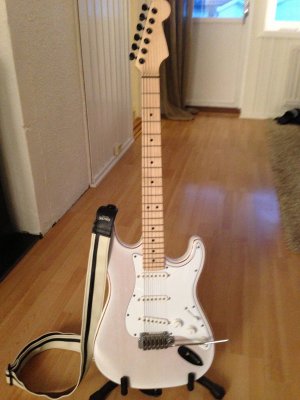Hello everyone, new user here :hello2:
I have a "problem" that's been bothering me for some time now, so I finally decided to do something about it.
I have a strat that I built a few years back, using a Warmoth neck and body.
The guitar plays great, so no worries there.
The problem is that the high E-string sounds "dead"/"tinny" and lower in volume than the rest of the strings when played acoustically.
This also seems to be the case when plugged in as well, but perhaps to a lesser extent. For example: if I play an E-chord, the high E-string kind of gets "lost" (hope this makes some kind of sense). :dontknow:
The body is chambered and made of swamp ash, routed H-S-S.
Neck is a Warmoth modern, maple, standard thin profile, 10-16" radius with jumbo stainless steel frets, the nut is corian.
The hardware is Gotoh staggered locking tuners and a Wilkinson VS100 bridge with tremol-no.
Pickups are a set of DiMarzio Injectors with an Area 67 in the middle.
I have the neck set up with just a hint of relief, string height is about 2mm on the low E, and about 1,6mm on the high E (measured at the 12th fret).
There is no fret buzz whatsoever with normal playing.
I really am quite puzzled by the whole thing and could use some advice.
Could it be an issue with the neck? I don't have a spare neck laying around or I would have tried swapping.
Well, I guess that's all for now. Any advice would be appreciated
I have a "problem" that's been bothering me for some time now, so I finally decided to do something about it.
I have a strat that I built a few years back, using a Warmoth neck and body.
The guitar plays great, so no worries there.
The problem is that the high E-string sounds "dead"/"tinny" and lower in volume than the rest of the strings when played acoustically.
This also seems to be the case when plugged in as well, but perhaps to a lesser extent. For example: if I play an E-chord, the high E-string kind of gets "lost" (hope this makes some kind of sense). :dontknow:
The body is chambered and made of swamp ash, routed H-S-S.
Neck is a Warmoth modern, maple, standard thin profile, 10-16" radius with jumbo stainless steel frets, the nut is corian.
The hardware is Gotoh staggered locking tuners and a Wilkinson VS100 bridge with tremol-no.
Pickups are a set of DiMarzio Injectors with an Area 67 in the middle.
I have the neck set up with just a hint of relief, string height is about 2mm on the low E, and about 1,6mm on the high E (measured at the 12th fret).
There is no fret buzz whatsoever with normal playing.
I really am quite puzzled by the whole thing and could use some advice.
Could it be an issue with the neck? I don't have a spare neck laying around or I would have tried swapping.
Well, I guess that's all for now. Any advice would be appreciated



